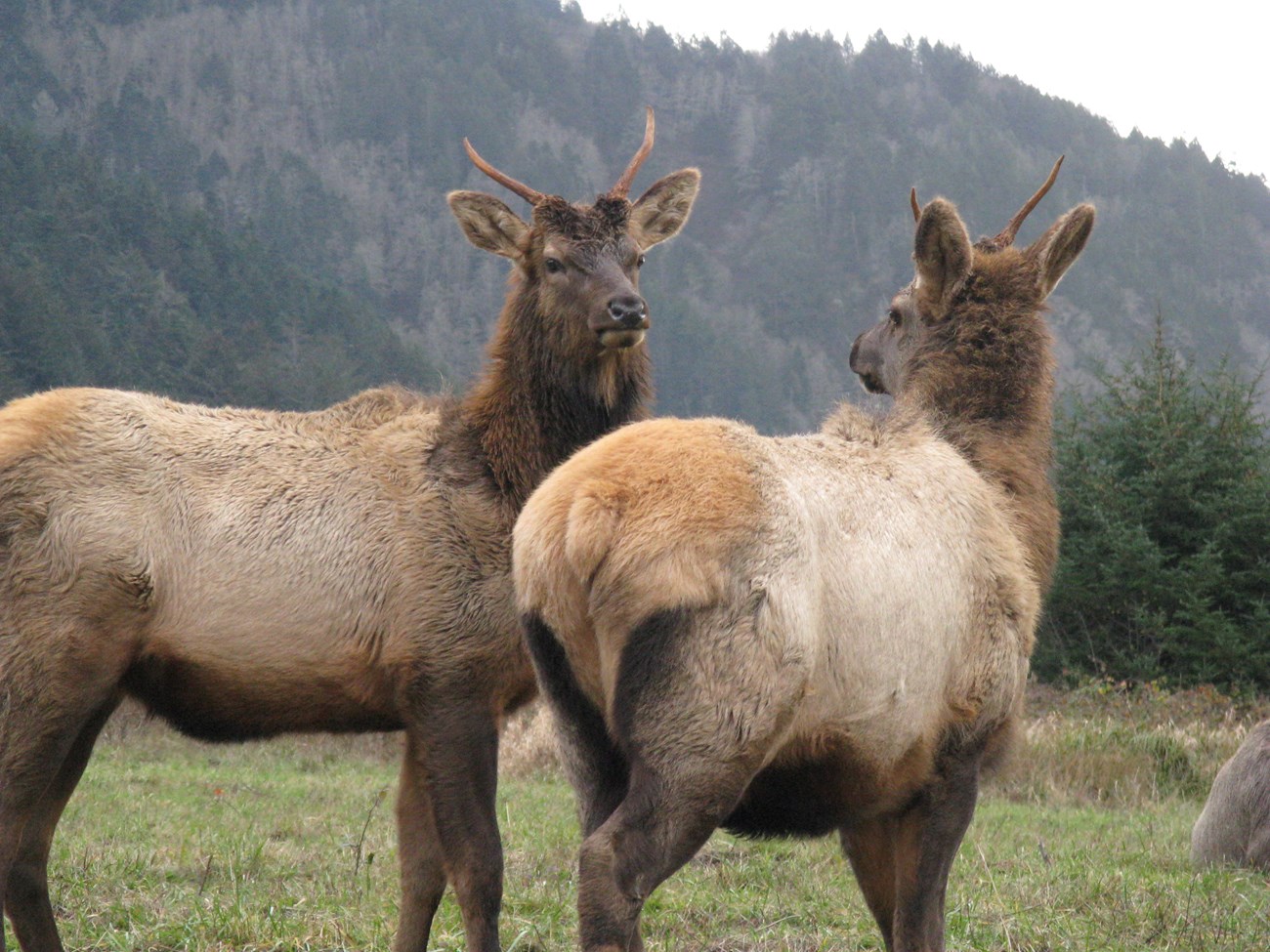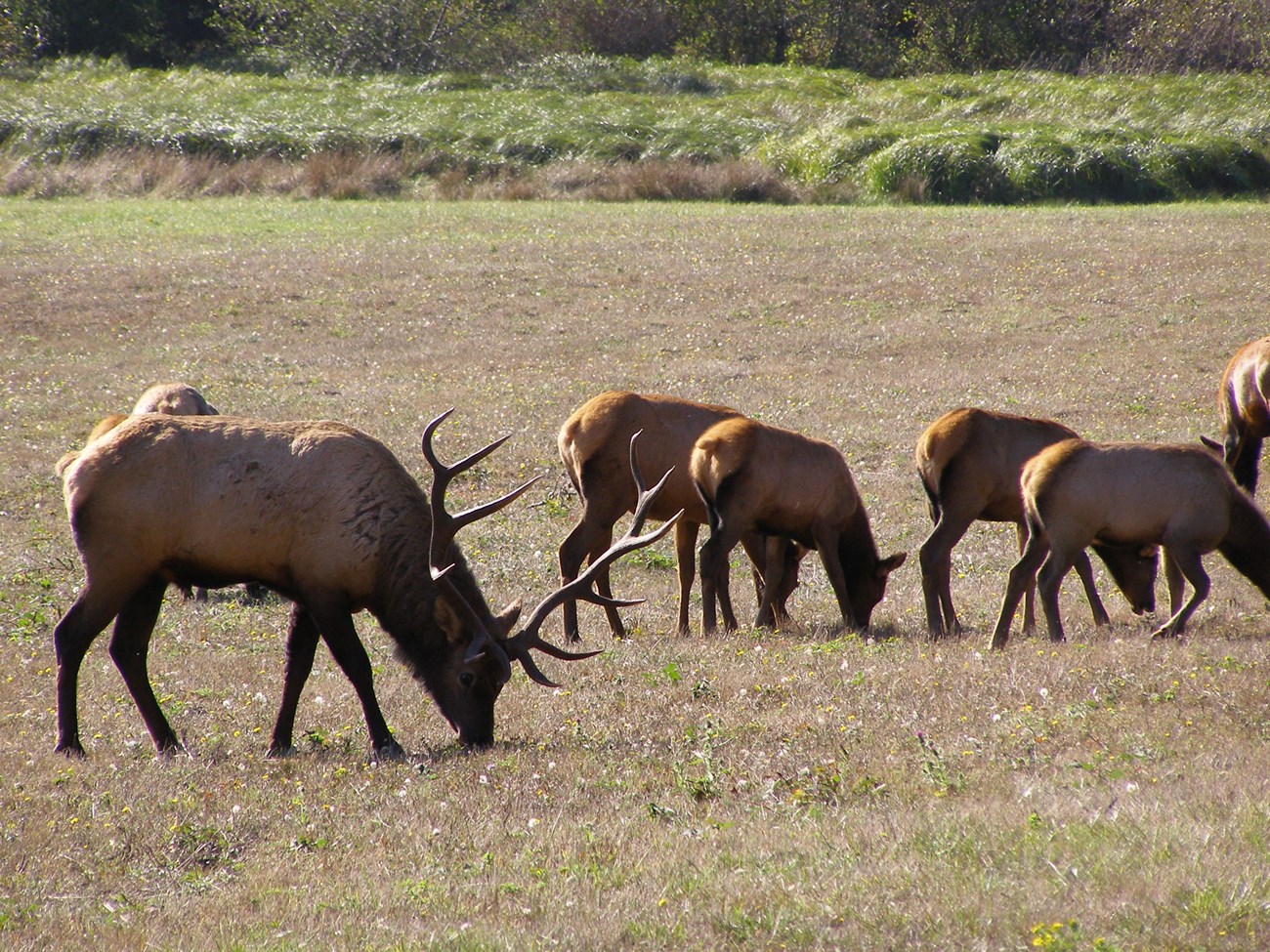Last updated: September 28, 2021
Article
Roosevelt Elk

NPS
General Description
Roosevelt elk (Cervus elaphus roosevelti) are a subspecies of the North American elk (Cervus elaphus). They are brown and slightly darker than their counterpart, the Rocky Mountain elk (C. e. nelsoni), with a dark mane and off-white rump patch. They stand 0.75–1.7 m (2.5–5.6 ft) at the withers, the highest part of their back. They can range between 2.1 and 2.6 m (6.9–8.5 ft) long and weigh between 171 and 497 kg (377–1096 lbs). These stats make elk one of the largest members of the deer family, Cervidae, which includes deer, elk, moose, and caribou. Males, or bulls, are larger than females (cows) and have large antlers, usually with six tines, that they shed and regrow every year!
Habitat and Distribution
Roosevelt elk live in coastal forests and mountains throughout the Pacific Northwest, west of the Cascades, from northern California to southern British Columbia and Alaska. They prefer “edge” environments, such as grassy fields near forested areas, which offer quick protection from lurking predators or poor weather conditions. This species is also seasonally migratory, travelling from higher elevations in the summer months to valleys in the winter in search of food and shelter.
Diet
Elk are herbivores, meaning that they only eat plants. In the spring and summer, they will primarily graze on low-lying grasses, flowers, ferns, lichens, and shrubs. In fall and winter, they browse on higher-growing vegetation such as sprouts and branches of shrubs and trees that are within reach. They will often consume a favorite food until it is gone before moving on to their next favorite, and then their next, and so on. Heavy browsing or too many elk can, in turn, leave an area overgrazed and depleted.
Behavior
Cows and their young live in loose herds, while bulls live alone or in “bachelor” groups until the mating season. Elk communicate by bugling, which is a combination of roaring and whistling at the same time. This is especially common by bulls competing for dominance during the mating season. Elk may also squeal, bark, chirp, mew, or use body language to communicate with one another.

NPS
Reproduction
Elk reach maturity around the age of two, although bulls may not mate until they are older. A mature single bull will attract a small group of cows and work to expel other males from the group. Elk rut, or mating, in these groups occurs in late summer and fall. During this time, bulls become more aggressive and will charge at one another and lock antlers to battle for dominant status and access to females. While competition can be high, it is more commonly a display of their antlers, necks, and bodies than an opportunity to harm others. When mating is successful, cows bear a single calf the following spring. Elk calves are born spotted and will spend their first few weeks of life hiding from predators before joining the herd.
Predators
As part of the food web, Roosevelt elk fall prey to grey wolves (Canis lupus), mountain lions (Puma concolor), black bears (Ursus americanus), and humans.
Fun Facts
• Elk is one of the largest deer species on Earth, and Roosevelt elk is the largest variety of elk in North America
• Roosevelt elk are named after one President Roosevelt. Can you guess which one? (*answer at the bottom of the page)
Conservation Status
Elk populations declined dramatically during the late 1800s with westward expansion of European-descendent settlers and agriculture. By 1907, an estimated 10 million elk that once roamed across North America were reduced to less than 100,000 individuals. This spurred wide-scale conservation efforts, including the creation of Prairie Creek Redwoods State Park to save one of the last wild herds of Roosevelt elk alongside old growth forest in California. Additionally, Mount Olympus National Monument (now Olympic National Park) was established as a Roosevelt elk reserve. Today, elk still face habitat loss from logging and road construction. Roosevelt elk are hunted as a game species in both California and Oregon.
Where to See
While elk occur across much of the western United States, the two Klamath Network parks in which Roosevelt elk occur are Redwoods National and State Parks and Crater Lake National Park.
More Information
Elk bugling:
https://www.nps.gov/yell/learn/photosmultimedia/sounds-elk.htm
https://www.fws.gov/refuge/Siletz_Bay/wildlife_and_habitat/roosevelt_elk.html
*President Theodore (“Teddy”) Roosevelt
Download a pdf of this article.
Prepared by Cassandra Fricke, Southern Oregon University science communication intern
NPS Klamath Inventory & Monitoring Network
Southern Oregon University
1250 Siskiyou Blvd
Ashland, OR 97520
Featured Creature Edition: September 2021
